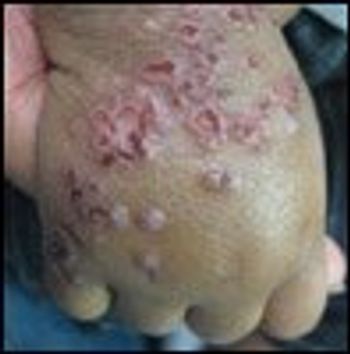
Vascular birthmarks are very common in newborns, and some varieties affect up to 50% of babies.

Vascular birthmarks are very common in newborns, and some varieties affect up to 50% of babies.

Mixing insulin detemir with aspart is equivalent to giving the 2 medications as separate injections in children with type 1 diabetes.

A 15-year-old girl is desperate for you to treat brown bumps on her chest, neck and trunk that have increased in number over the last 8 years.

Breast masses can cause anxiety for adolescent girls and their parents.

To help healthcare providers navigate through the language of HIT requirements in order to quality for EHR incentive payments, CMS has launched an official informational website for the Medicare and Medicaid incentive programs scheduled to begin in 2011.

The American College of Obstetricians and Gynecologists has issued a new committee opinion stating that the first dedicated reproductive health visit should take place when a girl is between 13 and 15 years.

A retraction pocket is to be differentiated from the common and usually benigh simple retracted tympanic membrane, which is often detected in a child with a simple upper respiratory infection.

After developing fever and left-sided lower back pain, a previously healthy 15-year-old boy had been diagnosed by his private physician with a urinary tract infection and treated with trimethorpim-sulfamethoxazole for 7 days.

FDA has authorized for use a new test for the diagnosis of H1N1 influenza virus infections. This test was developed by the CDC.

Investigators tested the hypothesis that analysis of gene expression of circulating white blood cells or of plasma cytokines can be used to improve diagnostic accuracy in children being evaluated for appendicitis.

FDA will now periodically prepare and post summaries of safety analyses on recently approved products as well as steps the agency is taking to address safety issues.

FDA has approved alglucosidase for patients aged 8 years and older for the treatment of late-onset Pompe disease.

On June 4, the Health Information Technology Policy Committee's meaningful use workgroup gave testimony on how to include in the definition of "meaningful use" measures that could reduce racial, ethnic or any other disparities in the health of patients.

With the recent and highly publicized tragedy involving a Delaware pediatrician arrested and charged with 471 criminal counts of sexual abuse of patients more than 12 years old, I believe we are all called on to examine our office practice of examination and anticipatory guidance.

Exposure to PCBs is associated with immunotoxic effects on serum concentration of specific antibodies against diphtheria and tetanus vaccinations, according to new research.

More than 50% of primary care physicians say that they are underprepared to diagnose and treat patients with bipolar disorder.

I read with interest Drs Ha and Wilson’s “What’s Your Diagnosis?” case of an infant with a history of wheezing and dry cough ("History of Cough in an Infant and a Toddler"). In a setting such as this, one should also consider the possibility of foreign-body aspiration, which can result in recurring wheezing and pneumonia.

Here: a "how to" on Gomco circumcision, the method most commonly used in the US.

Thoughts of my summer vacation are on the back burner now as I prepare to welcome the incoming pediatric residents. July 1st has a special meaning to all of us who have survived the grind of an internship. Fear was probably my main emotion at the start of my residency, while I’m sure for others it was excitement and anticipation. On July 8, I have to give a talk to the newcomers at our institution.

An 18-year-old boy presented with a several-month history of an intermittent, very pruritic rash on his back that did not improve with topical corticosteroids. Physical examination revealed grouped erythematous papules with a few scattered small vesicles on his posterior neck and bilateral posterior shoulders at the location where his backpack frequently rubbed.

A 1-year-old boy presented with a 10-day history of a nonpruritic rash that had persisted and spread despite treatment with a topical corticosteroid. Mother reported that he was febrile at the onset of the eruption; he was given over-the-counter antipyretics. On day 3, his pediatrician evaluated his condition and prescribed amoxicillin for his fever and hydrocortisone cream for his atopic dermatitis. Over the next several days, the fever subsided; however, the rash, which had started on the child’s right hand, persisted and spread to his face and elsewhere.

A 3-month-old boy was brought by his mother to his busy primary care physician’s office for follow-up of bronchiolitis when numerous bruises were noted. The mother said that the infant had a 1-week history of unexplained bruising, petechiae, and irritability. The child was referred to the local emergency department (ED) because of concern for nonaccidental trauma.

The mother of this 7-year-old girl originally thought these peculiar scales in her daughter’s scalp and hair were nits, since there had recently been an outbreak of head lice at the child’s school. However, she was not able to find any lice, and the scales resisted removal with mineral oil and a “nit comb.”

I’ve just committed my family to a 5-day July vacation to Orlando so we can visit a new amusement park dedicated to Harry Potter. The famous series of books about the teenage wizard has really sparked the love of reading in many children, including mine. My kids are really excited about seeing Hogwarts come to life, but my husband is not so thrilled about being in the potentially sweltering heat of Florida in the middle of the summer.

HPV Vaccine : Meeting the challenges Puzzler : Teen troubled by trembling leg Dermcase : Swollen extremities threaten infant Drug-hormonal contraception interactions

Medical myths persist even today.

Switching medications or combining medicine with cognitive behavior therapy eliminated symptoms of depression in more than one-third of teenagers who were resistant to treatment, new findings show.

Human papillomavirus vaccines are a promising technology for primary prevention of cervical cancer and the other HPV-related diseases, but achieving high rates of vaccination in the age group targeted for vaccination presents a challenge. Pediatricians play a vital role in implementing national recommendations for HPV vaccination for children and adolescents.

A 3-week-old baby boy is brought to the emergency depratment with swelling of hands and feet. His extremities were edematous, erythematous, and appeared painful.

A mother's antibodies that can help shield her infant from getting measles may not last long, according to new research.